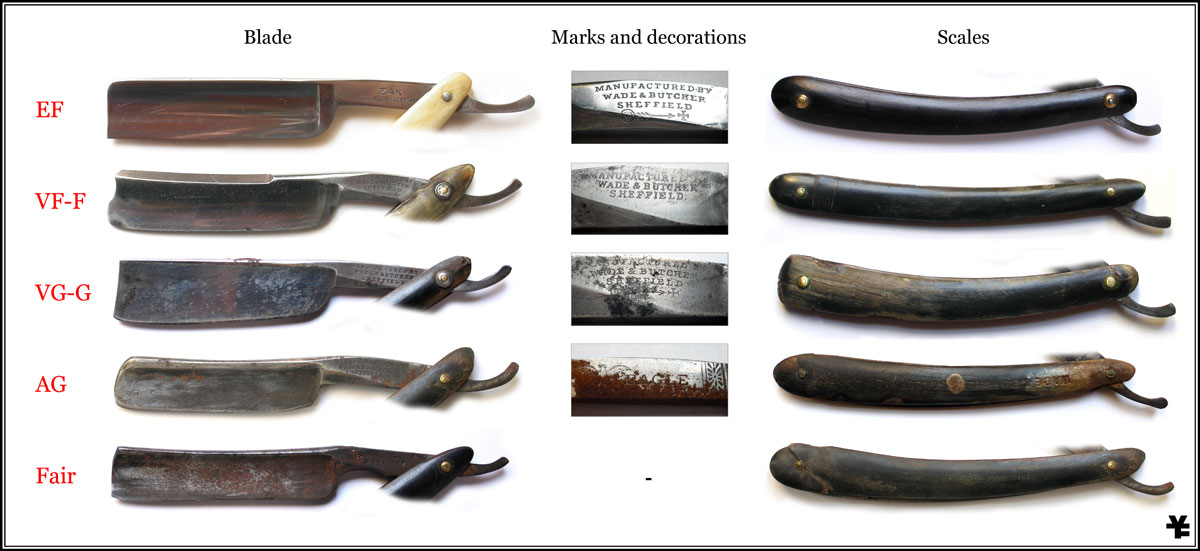Difference between revisions of "Straight Razor Grading"
Clavichord (talk | contribs) (→Introduction) |
m (Fixed minor formatting issues and typos.) |
||
| Line 1: | Line 1: | ||
| − | + | While determining an exact grade requires some skill, getting a ballpark idea is within the realm of everyone who can read this page. Straight razor grading is done evaluating separately three aspects: the blade, marks and decorations on the blade, the scales. Following a long tradition of coin collecting, the nomenclature is as follow: MS = mint; EF = extremely fine; VF = very fine; F = fine; VG = very good; G = good; AG = almost good; Fair = fair; Basal = basal state. Results are expressed in this way: [''blade'', ''marks&decorations'', ''scales'']. In case of evidently not original scales, the respective grade must be indicated between round brackets. This is an example of straight razor grading notation: [F,VG,(MS)]. For each grade (see below), one element of the list is enough to configure the razor part as belonging to the considered grade (ex: a blade with dark blemishes is VG even without traces of oxidation). | |
| − | |||
| − | |||
| − | |||
| − | While determining an exact grade requires some skill, getting a ballpark idea is within the realm of everyone who can read this page. Straight razor grading is done evaluating separately three aspects: the blade, marks and decorations on the blade, the scales. Following a long tradition of coin collecting, the nomenclature is as follow: MS = mint; EF = extremely fine; VF = very fine; F = fine; VG = very good; G = good; AG = | ||
| − | |||
| − | |||
| − | |||
| − | |||
== Blade == | == Blade == | ||
| − | |||
'''MS''': as new and never circulated; no traces of honing; | '''MS''': as new and never circulated; no traces of honing; | ||
| Line 26: | Line 17: | ||
'''Basal''': you can identify the lump of metal as being a razor. | '''Basal''': you can identify the lump of metal as being a razor. | ||
| − | |||
| − | |||
| − | |||
== Marks and decorations == | == Marks and decorations == | ||
| − | |||
'''MS''': as new, never circulated; | '''MS''': as new, never circulated; | ||
| Line 46: | Line 33: | ||
'''Basal''': completely deleted. | '''Basal''': completely deleted. | ||
| − | |||
| − | |||
| − | |||
== Scales == | == Scales == | ||
| − | |||
'''MS''': as new, never circulated; | '''MS''': as new, never circulated; | ||
| Line 65: | Line 48: | ||
'''Basal''': fragments of scales. | '''Basal''': fragments of scales. | ||
| − | |||
| − | |||
| − | |||
| − | |||
== Visual guide == | == Visual guide == | ||
| − | |||
[[Image:StraightRazorGrading.jpg]] | [[Image:StraightRazorGrading.jpg]] | ||
| − | |||
--[[User:Clavichord|Clavichord]] 22:22, 19 April 2009 (UTC) | --[[User:Clavichord|Clavichord]] 22:22, 19 April 2009 (UTC) | ||
| − | |||
[[Category:Historic_Shaving_Tools]] | [[Category:Historic_Shaving_Tools]] | ||
Revision as of 03:39, 20 April 2009
While determining an exact grade requires some skill, getting a ballpark idea is within the realm of everyone who can read this page. Straight razor grading is done evaluating separately three aspects: the blade, marks and decorations on the blade, the scales. Following a long tradition of coin collecting, the nomenclature is as follow: MS = mint; EF = extremely fine; VF = very fine; F = fine; VG = very good; G = good; AG = almost good; Fair = fair; Basal = basal state. Results are expressed in this way: [blade, marks&decorations, scales]. In case of evidently not original scales, the respective grade must be indicated between round brackets. This is an example of straight razor grading notation: [F,VG,(MS)]. For each grade (see below), one element of the list is enough to configure the razor part as belonging to the considered grade (ex: a blade with dark blemishes is VG even without traces of oxidation).
Blade
MS: as new and never circulated; no traces of honing;
EF: as new; barely visible and uniform honing wear;
VF-F: no traces of oxidation; little darker blemishes, patina, visible and uniform honing wear;
VG-G: little traces of oxidation, dark blemishes, patina, little changes of the blade shape (simmetry, grind, size) due to honing wear;
AG: extended traces of oxidation, extended changes of the blade shape due to honing wear;
Fair: cracks, heavy oxidation, heavy honing wear;
Basal: you can identify the lump of metal as being a razor.
Marks and decorations
MS: as new, never circulated;
EF: as new;
VF-F: slightly worn but completely visible;
VG-G: worn or damaged but completely visible;
AG: partially invisible;
Fair: almost completely invisible or unreadable (just traces of their existence).
Basal: completely deleted.
Scales
MS: as new, never circulated;
EF: as new, no marks or blemishes;
VF-F: small marks or blemishes, no chips cracks or deformation; original pins, if loose still with centered action;
VG-G: marks, small chips or deformations; original pins;
AG: evident chips or deformation; pins could have been replaced;
Fair: cracked; replaced or lacking pins;
Basal: fragments of scales.
Visual guide
--Clavichord 22:22, 19 April 2009 (UTC)
